 Headquarters in Shibuya, Tokyo Headquarters in Shibuya, Tokyo | |
| Native name | カシオ計算機株式会社 |
|---|---|
| Romanized name | Kashio Keisanki Kabushiki-gaisha |
| Company type | Public |
| Traded as | TYO: 6952 |
| Industry | Electronics |
| Founded |
|
| Founders |
|
| Headquarters | Shibuya, Tokyo, Japan |
| Area served | Worldwide |
| Key people | Yuichi Masuda (president and CEO) |
| Products | |
| Revenue | |
| Operating income | |
| Net income | |
| Total assets | |
| Total equity | |
| Number of employees | 9,594 (2024) |
| Website | world |
Casio Computer Co., Ltd. (カシオ計算機株式会社, Kashio Keisanki Kabushiki-gaisha) is a Japanese multinational electronics manufacturing corporation headquartered in Shibuya, Tokyo, Japan. Its products include calculators, mobile phones, digital cameras, electronic musical instruments, and analogue and digital watches. It was founded in 1946, and in 1957 introduced the first entirely compact electronic calculator. It was an early digital camera innovator, and during the 1980s and 1990s, the company developed numerous affordable home electronic keyboards for musicians along with introducing the first mass-produced digital watches.
History
Casio was established as Kashio Seisakujo in April 1946 by Tadao Kashio [ja] (1917–1993), an engineer specializing in fabrication technology. Kashio's first major product was the yubiwa pipe, a finger ring that would hold a cigarette, allowing the wearer to smoke the cigarette down to its nub while also leaving the wearer's hands free. Japan was impoverished immediately following World War II, so cigarettes were valuable, and the invention was a success.
After seeing the electric calculators at the first Business Show in Ginza, Tokyo in 1949, Kashio and his younger brothers (Toshio, Kazuo, and Yukio) used their profits from the yubiwa pipe to develop their calculators. Most of the calculators at that time worked using gears and could be operated by hand using a crank or using a motor (see adding machine).

Toshio possessed some knowledge of electronics and set out to make a calculator using solenoids. After dozens of prototypes were tested, the desk-sized calculator was finished in 1954 and was Japan's first electro-mechanical calculator. One of the central and more important innovations of the calculator was its adoption of the 10-key number pad; at that time other calculators were using a "full keypad", which meant that each place in the number (1s, 10s, 100s, etc. ...) had nine keys. Another distinguishing innovation was the use of a single display window instead of the three display windows (one for each argument and one for the answer) used in other calculators.
Casio Computer Co., Ltd. was formed in June 1957. That year, Casio released the Model 14-A, sold for 485,000 yen, the first all-electric compact calculator, which was based on relay technology.
In 1974, Casio released their first digital wristwatch, called the CASIOTRON. It was the first wristwatch in the world to include an automatic calendar function. In 1977, they released a retro-futuristic wristwatch, called the F100. The watch was one of the first wristwatches in the world to be made primarily out of resin, making it very light compared to other companies' heavy metal-made watches and enabling future Casio watches to enter mass production more easily. In 1989, Casio released another important wristwatch; the F-91W, the most sold wristwatch in the world with an annual production of 3 million units.
In the 1980s, Casio's budget electronic instruments and its line of affordable home electronic musical keyboard instruments became popular. The company also became well known for the wide variety and innovation of its wristwatches. It was one of the earliest manufacturers of quartz watches, both digital and analog. It also began selling calculator watches during this time. Casio also introduced one of the first watches that could display the time in many different time zones of the world and with features like recording temperature, atmospheric-pressure and altitude. In the later years, Casio's wristwatches were fitted with receivers to synchronise with radio towers around the world and Global Positioning System for timekeeping accuracy.
A number of notable digital camera innovations have also been made by Casio, including the QV-10, the first consumer digital camera with a liquid-crystal display (LCD) on the back (developed by a team led by Hiroyuki Suetaka in 1995), the first consumer three-megapixel camera, the first true ultra-compact model, and the first digital camera to incorporate ceramic lens technology, using Lumicera.
In July 2019, the company's UK arm, Casio Electronics Co. Ltd, was fined £3.7 million after admitting resale price maintenance (a form of price-fixing) on their line of digital keyboards and digital pianos between 2013 and 2018, in breach of the United Kingdom's Competition Act 1998.
Products
Casio's products include watches, calculators, electronic keyboards and other digital products such as digital cameras (Exilim series), film cameras, cash registers, laptops and sub-notebook computers, mobile phones, PDAs (E-Data Bank), electronic dictionaries, digital diaries (early PDAs), electronic games, personal computers (e.g. FP-1000, FP-200), computer printers, clocks, and portable televisions.
In the 1970s and 80s, Casio was best known for its electronic (including scientific) calculators, electronic musical instruments and affordable digital watches incorporating innovative technology. Today, Casio is most commonly known for making durable and reliable electronic products. The G-Shock range of shock-resistant watches is also very popular, with the original 1983 G-Shock DW-5000C being highly sought-after by collectors. The scientific calculators made by Casio especially the CLASSWIZ series of calculators are known for being affordable while incorporating a host of functions as compared to their competitors.
Casio also makes products for local markets, including "Prayer Compass" watch series designed to help Muslims pray on time and in the right direction.
Gallery
-
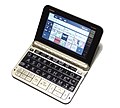 EX-word XD-Z6500 Electronic dictionary
EX-word XD-Z6500 Electronic dictionary
-
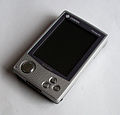 Cassiopeia PDA
Cassiopeia PDA
-
 ZR800 Digital camera
ZR800 Digital camera
-
 EX-S1 and EX-S600 Digital cameras
EX-S1 and EX-S600 Digital cameras
-
 W63CA Mobile phone
W63CA Mobile phone
-
 V.P.A.M. fx-122S Scientific calculator
V.P.A.M. fx-122S Scientific calculator
-
 fx-102 (1976)
fx-102 (1976)
-
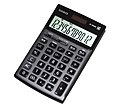 JF-20WK premium desk calculator
JF-20WK premium desk calculator
-
 fx-115ES Scientific calculator with Natural Display
fx-115ES Scientific calculator with Natural Display
-
 FC-100V financial calculator
FC-100V financial calculator
-
 QL-10 Pocket calculator with a built in cigarette lighter
QL-10 Pocket calculator with a built in cigarette lighter
-
Casio FX-700P programmable calculator
-
fx-7000G, the first graphing calculator
-
 FX CP-400 Classpad colour touchscreen calculator
FX CP-400 Classpad colour touchscreen calculator
-
 PB-110 Databank calculator with external tape recorder dock
PB-110 Databank calculator with external tape recorder dock
-
 V-R200 point of sale system
V-R200 point of sale system
-
KL-60 Label Printer
-
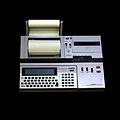 PB-770 pocket computer, with FA-11 extension dock
PB-770 pocket computer, with FA-11 extension dock
-
SF-R20 Digital Diary (early PDA)
-
 TS-150 watch (left) and FX-991EX scientific calculator (right)
TS-150 watch (left) and FX-991EX scientific calculator (right)
-
 Casio Sport OutGear SGW-400HD-1BV
Casio Sport OutGear SGW-400HD-1BV
-
 F-91W Digital watch
F-91W Digital watch
-
 MTP 4700 - Pilot watch
MTP 4700 - Pilot watch
-
 EFA 120 - Edifice watch
EFA 120 - Edifice watch
-
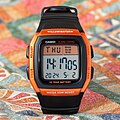 W-96H Digital watch
W-96H Digital watch
-
WMP1 portable MP3 watch
-
 GMW-B5000 A G-Shock watch with full metal construction
GMW-B5000 A G-Shock watch with full metal construction
-
 Edifice EQW-M1000 multi-function analog watch
Edifice EQW-M1000 multi-function analog watch
-
 Edifice ECB-800D-1A
Edifice ECB-800D-1A
-
 Edifice EQB-1100D-1A
Edifice EQB-1100D-1A
-
 ATC-1100 Triple Sensor Watch
ATC-1100 Triple Sensor Watch
-
Pro Trek PRW-1000TJ Triple Sensor Watch in compass mode
-
 ProTrek PRT-505 "TwinCept" watch
ProTrek PRT-505 "TwinCept" watch
-
 PRW-60Y ProTrek triple sensor ana-digi watch with tough movement technology
PRW-60Y ProTrek triple sensor ana-digi watch with tough movement technology
-
 G-Shock GW9400 Rangeman watch with triple sensors and tough solar technology
G-Shock GW9400 Rangeman watch with triple sensors and tough solar technology
-
 Tough Solar "Wave Ceptor" watch
Tough Solar "Wave Ceptor" watch
-
 VL-Tone VL-1
VL-Tone VL-1
-
 Sampletone SK-1
Sampletone SK-1
-
 Casiotone 201
Casiotone 201
-
 CZ-1 digital synthesizer
CZ-1 digital synthesizer
-
 AZ-1 keytar
AZ-1 keytar
-
 PG-380 MIDI Guitar
PG-380 MIDI Guitar
-
 DH-800 Digital Horn
DH-800 Digital Horn
-
 CTK-496 home keyboard
CTK-496 home keyboard
-
 WK-200 workstation keyboard
WK-200 workstation keyboard
-
 Privia PX-130 digital piano
Privia PX-130 digital piano
-
 Celviano AP-620
Celviano AP-620
-
 Privia PX-330
Privia PX-330
See also
Notes
References
- ^ "History". Casio Computer Co., Ltd. Retrieved 30 April 2012.
- "Company Data". Casio. Retrieved 23 February 2020.
- "Directors and Executive Officers". Casio.
- ^ "Casio Computer Co Corporation Financial Statements" (PDF). Casio Computer Co. Retrieved 2 October 2024.
- "Consolidated Financial Results for the Fiscal Year Ended Mar.31, 2024" (PDF). Casio Computer Co. Retrieved 2 October 2024.
- "CASIO Corporate History 1954". CASIO-Europe. CASIO Europe GmbH. Archived from the original on 19 February 2016. Retrieved 13 February 2016.
- "Tadao Kashio Biography: History of Casio Computer Company". 13 May 2015.
- Casio desktop calculator Archived 12 January 2008 at the Wayback Machine by Dentaku Museum.
- Houston, Keith (2023). Empire of the Sum: The Rise and Reign of the Pocket Calculator. Norton. ISBN 978-0-393-88214-8.
- "The History of Casio Watches". 23 March 2022.
- "This Casio is Inspired by the One from 'Alien'". 12 August 2021.
- "Casio F-91W – the classic quartz digital watch - ICON Magazine". 19 August 2011.
- ^ Review: Casio:History Archived 11 October 2016 at the Wayback Machine
- "Casio's ceramic lens". DPReview.
- Kollewe, Julia (22 January 2020). "Guitar maker Fender fined £4.5m for price fixing in UK". The Guardian. Retrieved 22 January 2020.
- "Piano supplier fined £3.7m for illegally preventing price discounts". Competition and Markets Authority. Retrieved 22 January 2020.
- "Casio CLASSWIZ FX-991EX Full Review". 21 March 2018. Retrieved 25 February 2019.
- "PRAYER COMPASS". Casio. Archived from the original on 16 March 2015. Retrieved 22 March 2015.
External links
 Media related to Casio at Wikimedia Commons
Media related to Casio at Wikimedia Commons- Casio Worldwide
| Casio | ||||||||||||||||||||||||
|---|---|---|---|---|---|---|---|---|---|---|---|---|---|---|---|---|---|---|---|---|---|---|---|---|
| Products |
| |||||||||||||||||||||||
| Other | ||||||||||||||||||||||||
| Casio calculators | ||
|---|---|---|
| Scientific Non-Programmable |
| 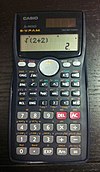 |
| Scientific Keystroke Programmable | ||
| Scientific BASIC Programmable | ||
| Graphing Programmable | ||
|
| Major point of sale companies | |
|---|---|
| Companies with an annual revenue of over US$3 billion | |
- Casio
- Japanese companies established in 1957
- 1970s initial public offerings
- Companies listed on the Tokyo Stock Exchange
- Companies in the Nikkei 225
- Computer companies established in 1957
- Defense companies of Japan
- Electronic calculator companies
- Electronics companies established in 1957
- Electronics companies of Japan
- Japanese brands
- Mobile phone manufacturers
- Audio equipment manufacturers of Japan
- Multinational companies headquartered in Japan
- Photography equipment manufacturers of Japan
- Piano manufacturing companies
- Point of sale companies
- Synthesizer manufacturing companies of Japan
- Watch brands
- Watch manufacturing companies of Japan
- Watchmaking conglomerates
- Companies related to wearable computers
- Musical instrument manufacturing companies of Japan